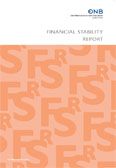Financial Stability Report 31
 OeNB
OeNB
- published:
- July 2016
 OeNB
OeNB
Management summary (PDF, 70 kB) en Jul 1, 2016, 12:00:00 AM
International macroeconomic environment: global financial stability risks are rising amid weaker world economy (PDF, 411 kB) en Jul 1, 2016, 12:00:00 AM
Corporate and household sectors in Austria: financing volumes start to rebound (PDF, 837 kB) en Jul 1, 2016, 12:00:00 AM
Austrian financial intermediaries: adaptation process continues in the financial sector (PDF, 1 MB) en Jul 1, 2016, 12:00:00 AM
The distribution of residential property price changes across homeowners and its implications for financial stability in Austria (PDF, 570 kB) Albacete, Fessler, Lindner. We employ newly available data of the second wave of the Eurosystem Household Finance and Consumption Survey (HFCS) for Austria to construct a house price index for an analysis of households’ financial resilience to possible price shocks in real estate markets. We estimate this house price index based on directly observed object-level information provided by homeowners. This results not only in an accurate index of house price developments as shown in the seminal contribution of Kiel and Zabel (1999), but also allows us to analyze the full distribution of house prices and their changes beyond the mean. We compare our approach to the two other price indices available in Austria, which use hedonic regressions based on transaction or quotation prices, and discuss advantages and disadvantages of the available indices while focusing on our primary objective, analyzing implications for financial stability. We find that the fairly steep increase of house prices recently observed has been driven by a rather small segment of the market. Further results suggest that the observed long-term real estate price increases have been remarkably stable. At the heart of our contribution is an analysis of the impact of house price changes on the loss given default of vulnerable mortgage holders. We base this analysis on scenarios that incorporate the observed empirical distribution of house price changes and show that the risks to financial stability are relatively limited. We conclude with a summary of the findings and provide a general assessment of the Austrian housing market. en household-specific property prices, mortgages, banking sector, Austria C81, D31, E21, E31, G21, O52, R31 Jul 1, 2016, 12:00:00 AM
Minimum requirement for own funds and eligible liabilities (MREL) – initial assessment for Austrian banks and selected subsidiaries in the EU (PDF, 355 kB) Langthaler, Metz, Pechmann, Richter, Rottensteiner, Unterkofler, Weiss. The minimum requirement for own funds and eligible liabilities (MREL) is a key element in bank resolution planning. It is particularly important for the effective application of the bail-in resolution tool which was introduced into EU law, together with MREL, with the Bank Recovery and Resolution Directive (BRRD) in 2014 and enacted in Austrian law in 2015. The purpose of MREL is to ensure that banks have adequate loss absorption and recapitalization resources in case of resolution. Given the narrow time schedule for implementing this new requirement, it is important to gain an understanding of the current situation for Austrian credit institutions and their EU subsidiaries in Central, Eastern and Southeastern Europe (CESEE). Therefore, the Austrian national resolution authority, i.e. the Financial Market Authority (FMA), together with the Oesterreichische Nationalbank conducted a survey among a selected sample of Austrian banks with the aim of assessing their MREL-eligible resources. The surveyed institutions were asked to provide data on the composition of their own funds and liabilities as per year-end 2014. The survey was designed to elicit answers to the most important questions arising from the implementation of MREL: How high is the current amount of MREL-eligible resources in the Austrian banking sector? How high is the amount that is available for bail-in in case of resolution? What is the current composition of MREL-eligible resources? Are there differences between different types of institutions? Are there enough MREL-eligible resources or are there any shortfalls? The supervisory and in particular the resolution authorities will need this information when setting MREL levels in order to assess impacts on major banking groups, to increase market transparency and to contribute to a stable regulatory environment in general. en minimum requirement for own funds and eligible liabilities (MREL), total loss-absorbing capacity (TLAC), BRRD, resolution, bail-in, Austrian banks, CESEE G21, G28, G31, G32, G33 Jul 1, 2016, 12:00:00 AM
Corporate financing in Austria in the run-up to capital markets union (This study is also available in German) (PDF, 514 kB) Elsinger, Köck, Kropp, Waschiczek. en European integration, capital markets union, corporate financing, disintermediation, risk capital F15, F36, G23, G3 Jul 1, 2016, 12:00:00 AM
Annex of tables (PDF, 180 kB) en Jul 1, 2016, 12:00:00 AM
Notes (PDF, 107 kB) en Jul 1, 2016, 12:00:00 AM